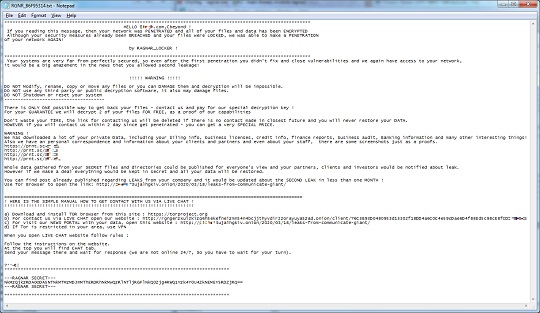Ransom.Win32.RAGNAR.A
Ransom:Win32/Ragnar!MSR (MICROSOFT); Trojan-Ransom.Ragnarlocker (IKARUS)
Windows


Threat Type: Ransomware
Destructiveness: No
Encrypted: No
In the wild: Yes
OVERVIEW
This Ransomware arrives on a system as a file dropped by other malware or as a file downloaded unknowingly by users when visiting malicious sites.
It drops files as ransom note. It avoids encrypting files with the following file extensions.
TECHNICAL DETAILS
Arrival Details
This Ransomware arrives on a system as a file dropped by other malware or as a file downloaded unknowingly by users when visiting malicious sites.
Installation
This Ransomware adds the following processes:
- wmic.exe shadowcopy delete → deletes shadow copies
- vssadmin delete shadows /all /quiet → deletes shadow copies
Process Termination
This Ransomware terminates processes or services that contain any of the following strings if found running in the affected system's memory:
- backup
- connectwise
- Dfs
- logme
- logmein
- memtas
- mepocs
- mysql
- pulseway
- sophos
- splashtop
- sql
- veeam
- vmcompute
- vmms
- vss
- agntsvc
- benetns
- bengine
- beremote
- beserver
- dbeng50
- dbsnmp
- dfsrs.exe
- dfssvc.exe
- EduLink2SIMS
- encsvc
- excel
- fdhost
- firefox
- infopath
- isqlplussvc
- msaccess
- mspub
- mydesktopqos
- mydesktopservice
- ocautoupds
- ocomm
- ocssd
- onenote
- oracle
- outlook
- OWSTIMER
- postgres
- powerpnt
- pvlsvr
- SAVAdminService
- SavService.exe
- sqbcoreservice
- steam
- swc_service.exe
- synctime
- tbirdconfig
- thebat
- thunderbird
- visio
- VxLockdownServer
- winword
- wordpad
- WSSADMIN
- wsstracing
- xfssvccon
Other Details
This Ransomware does the following:
- It checks for the computer's language and terminates itself if any the following language is detected:
- Armenian
- Azerbaijani
- Belorussian
- Georgian
- Kazakh
- Kyrgyz
- Moldavian
- Russian
- Tajik
- Turkmen
- Ukrainian
- Uzbek
It accepts the following parameters:
- -backup
- deletes shadow copies only
- -list {Text File}
- deletes shadow copies and encrypts only the directories indicated on the text file
- -force {Path}
- deletes shadow copies and encrypts only the path provided
- -vm
- deletes shadow copies and encrypts the whole machine avoiding files,folders and file extensions stated below.
Ransomware Routine
This Ransomware avoids encrypting files with the following strings in their file name:
- RGNR_{8 Characters based on Computer Name}.txt
- autorun.inf
- boot.ini
- bootfont.bin
- bootsect.bak
- bootmgr
- bootmgr.efi
- bootmgfw.efi
- desktop.ini
- iconcache.db
- ntldr
- ntuser.dat
- ntuser.dat.log
- ntuser.ini
- thumbs.db
It avoids encrypting files found in the following folders:
- Windows
- Windows.old
- Tor browser
- Internet Explorer
- Opera
- Opera Software
- Mozilla
- Mozilla Firefox
- $Recycle.Bin
- ProgramData
- All Users
It renames encrypted files using the following names:
- {Original Filename}.{Original File Extension}.ragnar_{8 Characters based on Computer Name}
It drops the following file(s) as ransom note:
- %Public%\Documents\RGNR_{8 Characters based on Computer Name}.txt
- {Encrypted Directory}\RGNR_{8 Characters based on Computer Name}.txt
(Note: %Public% is the folder that serves as a repository of files or folders common to all users, which is usually C:\Users\Public in Windows Vista, 7, and 8.)
It leaves text files that serve as ransom notes containing the following text:
It avoids encrypting files with the following file extensions:
- .db
- .sys
- .dll
- .lnk
- .msi
- .drv
- .exe
SOLUTION
Step 1
Trend Micro Predictive Machine Learning detects and blocks malware at the first sign of its existence, before it executes on your system. When enabled, your Trend Micro product detects this malware under the following machine learning name:
- Troj.Win32.TRX.XXPE50FFF035
Step 2
Before doing any scans, Windows 7, Windows 8, Windows 8.1, and Windows 10 users must disable System Restore to allow full scanning of their computers.
Step 3
Note that not all files, folders, and registry keys and entries are installed on your computer during this malware's/spyware's/grayware's execution. This may be due to incomplete installation or other operating system conditions. If you do not find the same files/folders/registry information, please proceed to the next step.
Step 4
Search and delete these files
- %Public%\Documents\RGNR_{8 Characters based on Computer Name}.txt
- {Encrypted Directory}\RGNR_{8 Characters based on Computer Name}.txt
Step 5
Scan your computer with your Trend Micro product to delete files detected as Ransom.Win32.RAGNAR.A. If the detected files have already been cleaned, deleted, or quarantined by your Trend Micro product, no further step is required. You may opt to simply delete the quarantined files. Please check the following Trend Micro Support pages for more information:
Step 6
Restore encrypted files from backup.
Did this description help? Tell us how we did.


